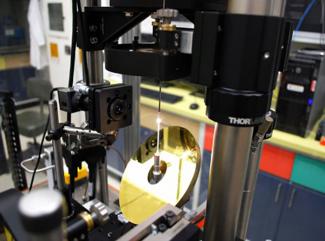Just as the newest jet aircraft technologies require cutting edge innovations like carbon-fiber composites, polymers, and avionics to make them fly, the next generation of high efficiency and environmentally sound energy-producing technologies demand a very specific set of functional materials to make them capable of answering the nation’s increasing energy needs.
NETL is internationally recognized for its success in designing, developing, and deploying functional materials tailored for use in energy applications and extreme service environments for next-generation energy technologies like solid oxide fuel cells, chemical looping, carbon capture, fuel processing, and many other applications.
“Functional materials are formulated specifically to perform unique and unusual functions or to exhibit properties not usually found in nature,” explained NETL’s Dr. Michael Buric. “Functional materials can include many types of materials; from ceramics and polymers, to alloys and sorbents. The study of functional materials focuses on designing, synthesizing, and performance testing a wide range of materials and selecting the best candidates for next-generation energy technologies.”
The new materials developed by NETL will lower the cost of and improve the performance of fossil-based power generation systems. Two technology areas affected by NETL’s continuing functional materials research are harsh-environment sensors and catalyst development.
Harsh Environment Sensing
Like your car, which has sensors to monitor its performance and provide feedback to the engine and safety systems, power plants can also benefit from improved sensor technologies that monitor plant operations. The challenge is that power plants and energy production facilities have some of the harshest, most difficult environments anywhere on the planet. Energy environments are much more intense than the temperature, pressure, light, and sound levels we experience in our everyday lives. Sensors required to monitor power plants must withstand these harsh environments for long service life spans.
NETL researchers use a wide variety of different types of lasers, waveguides, and fiber-optics, constructed using new materials engineered to survive the hottest, toughest environments possible. This requires a team with many different areas of expertise, including mechanical engineers, materials scientists and optics experts. The results of these collaborations are sensors that provide new measurements and pioneering monitoring strategies to make our energy production technologies more efficient so we can generate more power with fewer resources and less emissions.
Sensors enable operators to “see” inside harsh energy environments like turbines, boilers, or fuel cells where it would be physically impossible to travel. NETL researchers are designing innovative optical-sensors for a wide variety of applications. One team is focused on the detection of leaks or corrosion along the hundreds of kilometers of oil and gas pipelines spanning the country. NETL scientists are also working to monitor and control high-temperature fuel cells that convert hydrogen to electricity with virtually no emissions. Others work to measure the conditions inside industrial-scale gasifiers that convert coal or other fuels directly into electricity to improve efficiency and use less fuel. These dedicated individuals are constantly finding new ways to use new materials to improve the existing energy infrastructure; helping to make it cleaner, more efficient, more reliable for the future.
Catalyst Development
Catalysts are substances that speed up chemical reactions and are not consumed by the reaction. They are essential in many energy processes. NETL researchers are investigating how to make catalysts work even better in energy production. For example, one catalysis process that is of special interest to energy researchers is the Fischer-Tropsch catalysis that can be used to create liquid fuels and industrial chemicals without using petroleum. It has the potential to be a valuable tool for developing alternative sources of ultra-clean chemicals and fuels, while operating more efficiently and more environmentally friendly than traditional combustion methods. In short, it is a better way to use fossil resources such as natural gas and coal.
The process synthesizes liquid fuels and chemicals from a mixture of carbon monoxide and hydrogen known as synthesis gas (syngas) that can be made from coal, natural gas, and other fossil energy feedstocks. Although the process was discovered nearly a century ago, the problem is how to lower the operating and maintenance costs associated with commercial use of the process. That is where NETL’s researchers are involved. They are investigating ways to optimize catalyst activity and durability related to Fischer-Tropsch catalysis and to better understand how to tailor the process to create specific products.
A recent breakthrough by the NETL team is a new class of iron-based nanocatalysts that provide higher catalytic activity (so they work better and faster) and improved selectivity (so they are more easily tailored to create specific products). The new nanocatalyst also offers better stability for a longer life span.
The research offers an option for reducing our reliance on oil and creating opportunities to use sustainable sources, such as biomass, for chemical production. With continued research, this process may be optimized for wide-scale commercial deployment.
Increasing the efficiency of energy production with new materials that can endure the harsher environments will allow the nation to create more energy with less fuel and fewer emissions. NETL researchers are discovering and advancing technologies that will enable a cleaner energy future, enhancing energy security while protecting the environment for future generations.




